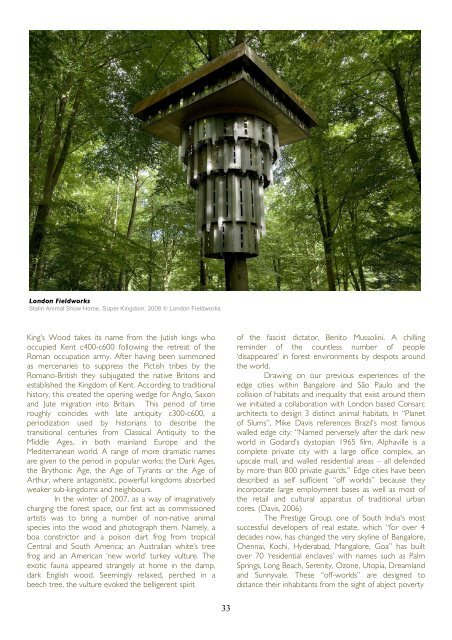M - Antennae The Journal of Nature in Visual Culture
M - Antennae The Journal of Nature in Visual Culture
M - Antennae The Journal of Nature in Visual Culture
Create successful ePaper yourself
Turn your PDF publications into a flip-book with our unique Google optimized e-Paper software.
London Fieldworks<br />
Stal<strong>in</strong> Animal Show Home, Super K<strong>in</strong>gdom, 2008 � London Fieldworks<br />
K<strong>in</strong>g’s Wood takes its name from the Jutish k<strong>in</strong>gs who<br />
occupied Kent c400-c600 follow<strong>in</strong>g the retreat <strong>of</strong> the<br />
Roman occupation army. After hav<strong>in</strong>g been summoned<br />
as mercenaries to suppress the Pictish tribes by the<br />
Romano-British they subjugated the native Britons and<br />
established the K<strong>in</strong>gdom <strong>of</strong> Kent. Accord<strong>in</strong>g to traditional<br />
history, this created the open<strong>in</strong>g wedge for Anglo, Saxon<br />
and Jute migration <strong>in</strong>to Brita<strong>in</strong>. This period <strong>of</strong> time<br />
roughly co<strong>in</strong>cides with late antiquity c300-c600, a<br />
periodization used by historians to describe the<br />
transitional centuries from Classical Antiquity to the<br />
Middle Ages, <strong>in</strong> both ma<strong>in</strong>land Europe and the<br />
Mediterranean world. A range <strong>of</strong> more dramatic names<br />
are given to the period <strong>in</strong> popular works: the Dark Ages,<br />
the Brythonic Age, the Age <strong>of</strong> Tyrants or the Age <strong>of</strong><br />
Arthur, where antagonistic, powerful k<strong>in</strong>gdoms absorbed<br />
weaker sub-k<strong>in</strong>gdoms and neighbours.<br />
In the w<strong>in</strong>ter <strong>of</strong> 2007, as a way <strong>of</strong> imag<strong>in</strong>atively<br />
charg<strong>in</strong>g the forest space, our first act as commissioned<br />
artists was to br<strong>in</strong>g a number <strong>of</strong> non-native animal<br />
species <strong>in</strong>to the wood and photograph them. Namely, a<br />
boa constrictor and a poison dart frog from tropical<br />
Central and South America; an Australian white’s tree<br />
frog and an American ‘new world’ turkey vulture. <strong>The</strong><br />
exotic fauna appeared strangely at home <strong>in</strong> the damp,<br />
dark English wood. Seem<strong>in</strong>gly relaxed, perched <strong>in</strong> a<br />
beech tree, the vulture evoked the belligerent spirit<br />
33<br />
<strong>of</strong> the fascist dictator, Benito Mussol<strong>in</strong>i. A chill<strong>in</strong>g<br />
rem<strong>in</strong>der <strong>of</strong> the countless number <strong>of</strong> people<br />
‘disappeared’ <strong>in</strong> forest environments by despots around<br />
the world.<br />
Draw<strong>in</strong>g on our previous experiences <strong>of</strong> the<br />
edge cities with<strong>in</strong> Bangalore and São Paulo and the<br />
collision <strong>of</strong> habitats and <strong>in</strong>equality that exist around them<br />
we <strong>in</strong>itiated a collaboration with London based Consarc<br />
architects to design 3 dist<strong>in</strong>ct animal habitats. In “Planet<br />
<strong>of</strong> Slums”, Mike Davis references Brazil’s most famous<br />
walled edge city: “Named perversely after the dark new<br />
world <strong>in</strong> Godard’s dystopian 1965 film, Alphaville is a<br />
complete private city with a large <strong>of</strong>fice complex, an<br />
upscale mall, and walled residential areas – all defended<br />
by more than 800 private guards.” Edge cities have been<br />
described as self sufficient “<strong>of</strong>f worlds” because they<br />
<strong>in</strong>corporate large employment bases as well as most <strong>of</strong><br />
the retail and cultural apparatus <strong>of</strong> traditional urban<br />
cores. (Davis, 2006)<br />
<strong>The</strong> Prestige Group, one <strong>of</strong> South India's most<br />
successful developers <strong>of</strong> real estate, which “for over 4<br />
decades now, has changed the very skyl<strong>in</strong>e <strong>of</strong> Bangalore,<br />
Chennai, Kochi, Hyderabad, Mangalore, Goa” has built<br />
over 70 ‘residential enclaves’ with names such as Palm<br />
Spr<strong>in</strong>gs, Long Beach, Serenity, Ozone, Utopia, Dreamland<br />
and Sunnyvale. <strong>The</strong>se “<strong>of</strong>f-worlds” are designed to<br />
distance their <strong>in</strong>habitants from the sight <strong>of</strong> abject poverty












